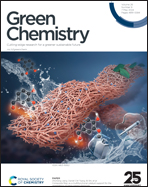Production of lignin containing cellulose nanofibrils (CNF) after enzymatic treatment of curl-induced, unbleached kraft pulps†
Abstract
Lignin-containing cellulose nanofibrils are successfully produced after enzymatic treatment of curl-induced, unbleached kraft pulps. An enzyme cocktail composed predominantly of endoglucases but also containing xylanases, laccases, and lytic polysaccharide monooxygenases (LPMO's) results in significant enzyme-mediated fiber modification. A substantial (70%) reduction in pulp viscosity can be achieved while enzyme treatment of curl-induced fibers results in improved fibrillation and increased colloidal stability. This is likely due to the higher negative charge density (−57.5 mV) of the fibers. The enzyme-treated, curl-derived cellulose nanofibrils show improved characteristics such as higher transmittance, lower viscosity, and thinner nanofibrils, resulting in enhanced nano-fibrillation. Superior mechanical properties, such as increasing the tensile strength of cellulose nanopapers to 150 MPa, are obtained as a result of the improved fibril network. The pre-curled fibers appear more accessible to enzyme treatment, resulting in cellulose nanofibrils with improved properties with less chemical treatments and mechanical refining energy required.



 Please wait while we load your content...
Please wait while we load your content...